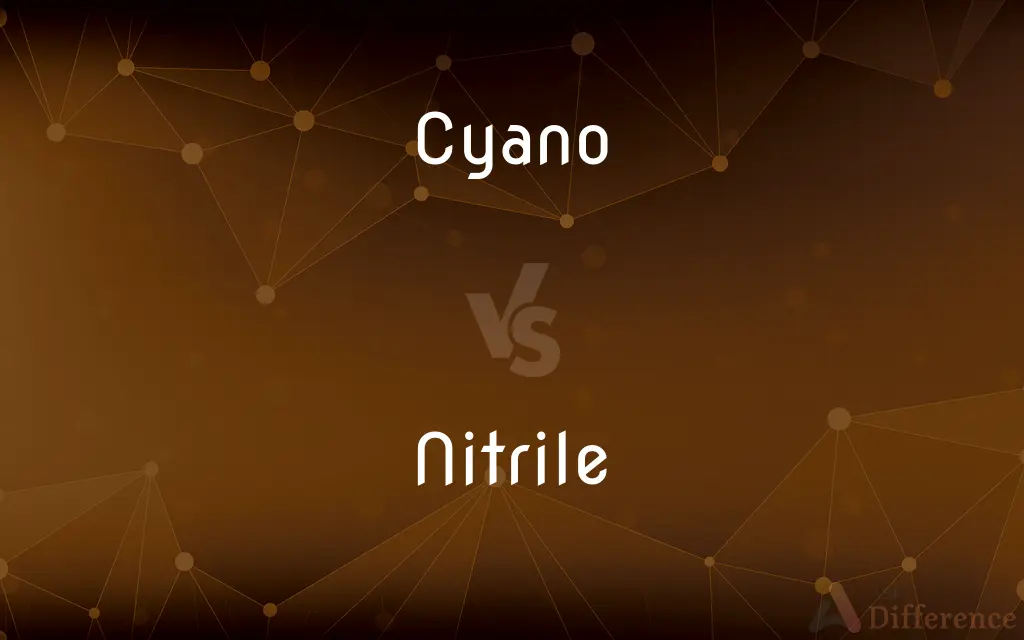Cyano vs. Nitrile — What's the Difference?
By Maham Liaqat & Urooj Arif — Updated on April 18, 2024
Cyano refers specifically to the functional group -C≡N in organic chemistry, integral to nitrile compounds; nitrile is the term for organic compounds containing the cyano group, usually attached to an alkyl or aryl group.

Difference Between Cyano and Nitrile
Table of Contents
ADVERTISEMENT
Key Differences
The term "cyano" specifically describes the cyano functional group (-C≡N), which is a carbon atom triple-bonded to a nitrogen atom. This group is a key feature in the chemistry of compounds containing this linkage. On the other hand, "nitrile" refers to any organic compound that incorporates the cyano group, typically attached to carbon-containing groups such as alkyl or aryl radicals.
While "cyano" is used to denote the presence of the -C≡N group within a larger molecule and is often used as a prefix in chemical nomenclature (e.g., cyanoacrylates, cyanobenzene), "nitrile" is used to classify a broader category of organic compounds. Nitriles are characterized by this functional group but are identified more generally by their structural context and properties.
The cyano group is known for its electronegativity due to the nitrogen atom, influencing the chemical behavior of the molecule, such as increasing acidity and reactivity. In contrast, nitriles as a class of compounds are recognized for their application in various industrial and pharmaceutical contexts, including the production of plastics, drugs, and synthetic fibers.
From a synthetic perspective, the cyano group in nitriles can be utilized in various chemical reactions, serving as a functional handle for further transformations. Nitrile compounds themselves are often synthesized from alcohols or halides through cyanation reactions.
In practical applications, you might encounter the term "cyano" when discussing specific functional groups within a molecule during chemical analysis or synthesis. "Nitrile," however, is more likely to appear in the context of material science, such as in the naming of nitrile rubber, or in discussions related to organic synthesis and pharmaceuticals.
ADVERTISEMENT
Comparison Chart
Definition
The functional group -C≡N in organic molecules.
Organic compounds containing the cyano group.
Usage in Chemistry
Used as a prefix in naming specific molecules.
Refers to a class of compounds.
Chemical Properties
Electronegative, affects molecule's reactivity and acidity.
Used in synthesis, important in industrial applications.
Examples
Cyanoacrylates, cyanobenzene.
Acetonitrile, benzonitrile.
Applications
Describes part of a molecule's structure in chemical discussions.
Used in the production of plastics, pharmaceuticals, and synthetic fibers.
Compare with Definitions
Cyano
Integral in various synthetic pathways.
Cyano compounds are key intermediates in the synthesis of amides.
Nitrile
Found in industrial and pharmaceutical applications.
Nitrile rubber is used in gloves and other protective gear.
Cyano
Functional group consisting of a carbon triple-bonded to a nitrogen.
Cyano groups are highly reactive in organic synthesis.
Nitrile
Produced from various organic precursors.
Nitriles are typically synthesized from alcohols through dehydration.
Cyano
Specific to the functional group, not the compound class.
The cyano group can be introduced into organic molecules through cyanation reactions.
Nitrile
A class of organic compounds containing the cyano group.
Acetonitrile is a simple nitrile used as a solvent in laboratories.
Cyano
Used as a prefix in chemical nomenclature.
Cyanobenzene is an aromatic compound with a cyano group attached to benzene.
Nitrile
Used in the production of other chemicals.
Nitriles can be hydrolyzed to produce carboxylic acids or amides.
Cyano
Impacts the chemical properties of compounds.
The cyano group increases the acidity of adjacent hydrogen atoms.
Nitrile
Characterized by the presence of a cyano group.
Benzonitrile contains a cyano group attached to an aromatic ring.
Cyano
A univalent functional group, -CN, consisting of a carbon and a nitrogen atom joined with a triple bond; organic compounds containing a cyano group are nitriles
Nitrile
A nitrile is any organic compound that has a −C≡N functional group. The prefix cyano- is used interchangeably with the term nitrile in industrial literature.
Nitrile
An organic molecule containing a CN group, an organic derivative of hydrocyanic acid.
Nitrile
An oil-resistant copolymer of acrylonitrile and butadiene, used especially for disposable gloves, gaskets, seals, and tubing. Also called nitrile rubber.
Nitrile
(organic chemistry) any of a class of organic compounds containing a cyano functional group -C≡N; they are named as derivatives of the appropriate carboxylic acid.
Nitrile
A type of synthetic rubber formed by the copolymerisation of acrylonitrile and butadiene.
Nitrile
Any one of a series of compounds bearing the cyanide radical (-CN); particularly, one of those cyanides of alcohol radicals which, by boiling with acids or alkalies, produce a carboxyl acid, with the elimination of the nitrogen as ammonia.
Nitrile
Any of a class of organic compounds containing the cyano radical -CN
Common Curiosities
Can cyano groups be found in all nitrile compounds?
Yes, all nitrile compounds contain at least one cyano group as part of their molecular structure.
What are common uses of nitriles?
Nitriles are used in the production of plastics, synthetic fibers, and pharmaceuticals, as well as in chemical synthesis.
What is the main difference between cyano and nitrile?
Cyano refers to the specific functional group -C≡N, while nitrile refers to the entire class of compounds that contain this group.
Where might you encounter cyano in chemistry?
Cyano is often mentioned when discussing the specific functional aspects of molecules, particularly in organic synthesis.
How are nitriles typically synthesized?
Nitriles are commonly synthesized from alcohols or halides through various cyanation reactions.
Can the terms cyano and nitrile be used interchangeably?
No, they refer to different things; cyano is the group itself, while nitrile denotes the class of compounds containing this group.
Are nitriles safe to handle?
Some nitriles can be hazardous due to their toxicity or volatility, so proper safety measures must be taken when handling them.
What are the environmental impacts of nitrile compounds?
The production and degradation of nitrile compounds can have environmental impacts, requiring careful management and disposal.
What makes the cyano group important in organic chemistry?
The cyano group's electronegativity affects the acidity and reactivity of molecules, making it a useful functional group in many chemical reactions.
How does the presence of a cyano group affect a molecule’s properties?
The cyano group increases a molecule's acidity and enhances its reactivity, influencing various chemical behaviors.
What is the role of nitriles in pharmaceuticals?
Nitriles serve as key intermediates in the synthesis of various drugs, offering structural diversity and specific pharmacological properties.
Is there a way to convert nitriles into other functional groups?
Nitriles can be converted into carboxylic acids, amides, or amines through various chemical reactions.
Why are nitriles important in material science?
Nitriles contribute properties like resistance to oils and solvents in materials such as nitrile rubber, widely used in protective gear.
How do cyano groups influence synthesis pathways?
Cyano groups can participate in multiple reaction pathways, such as nucleophilic addition or substitution, useful in complex molecule construction.
What are some safety tips for working with nitrile compounds?
Handling nitrile compounds should include proper ventilation, use of gloves, and adherence to material safety data sheets (MSDS).
Share Your Discovery

Previous Comparison
Figurehead vs. Leadership
Next Comparison
Neutralise vs. NeutralizeAuthor Spotlight
Written by
Maham LiaqatCo-written by
Urooj ArifUrooj is a skilled content writer at Ask Difference, known for her exceptional ability to simplify complex topics into engaging and informative content. With a passion for research and a flair for clear, concise writing, she consistently delivers articles that resonate with our diverse audience.
















































